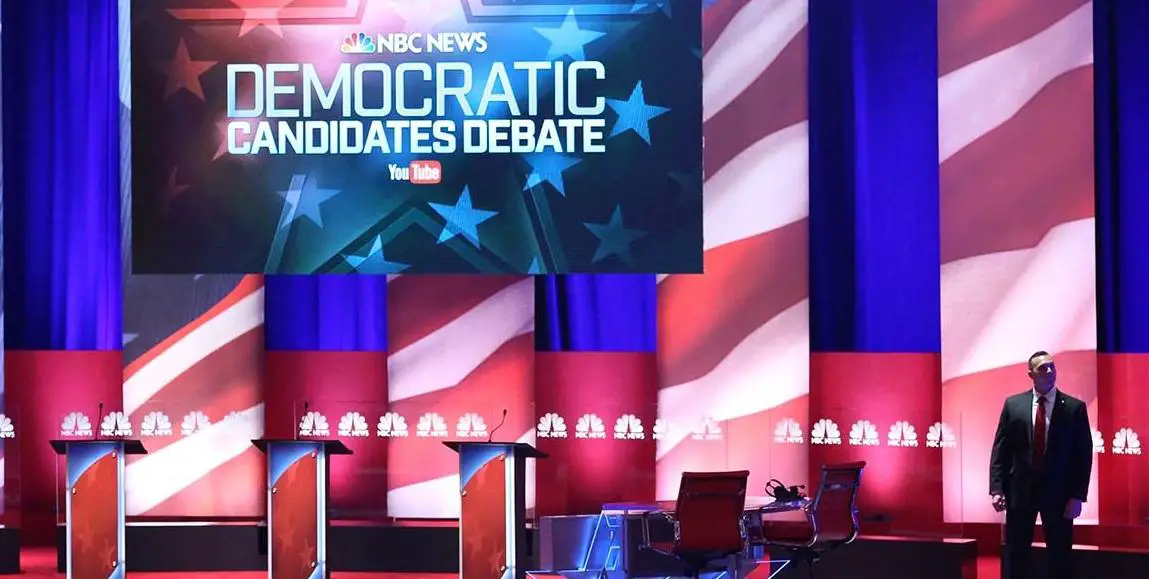There is just about one month to go until the first 2020 Democratic primary debate happens on June 26-27, live from Miami, Florida. At this point, there are at least 19 candidates who already make the cut, and it’s likely the final 20th spot will be filled by the time we get into mid-June. As it stands right now, there are several candidates who have technically qualified but based on a tie-breaking system, could be bumped outside the top twenty depending on the circumstances.
In that regard, candidates have begun making a great sprint by pulling out all the stops to ensure they meet both the fundraising and polling thresholds to qualify for the debate and move their name up the list of priority if more than 20 candidates meet the threshold.
As the Washington Times reports, several candidates, including New York’s Bill de Blasio, Colorado Sen. Michael Bennet, Rep. Seth Moulton of Massachusetts, Mayor Wayne Messam of Miramar, Florida, and former Sen. Mike Gravel of Alaska, are still hoping to get on the debate stage:
Failure to get into the first debates, set for June 26 and 27, in Miami, would deliver a potentially lethal blow to a presidential campaign.
“With a field that could easily swell to 30 candidates, it would be very difficult to make the case that you can compete in a general election if you can’t find enough support to qualify for the debates,” said Democratic strategist Zach Friend, who worked on Barack Obama’s 2008 campaign.
He noted the machinations by candidates and donors to meet the fundraising threshold of 65,000 individual donations spread across at least 20 states, which is easier to finagle than the alternative qualifier of getting 1% in at least three major polls.
“Many Democratic donors this cycle are donating to multiple campaigns, often with very small dollar donations, just to have candidates in the first debates,” he said. “Campaigns are getting creative, even trading merchandise for $1 and $5 donations, just to hit the minimum donor threshold to qualify for the debates.”
Washington Gov. Jay Inslee, whose run is focused on fighting climate change, is one of the candidates who appealed for contributions specifically to get into the debates.
“I’m asking for $5. Here’s why: The June debate is our next best shot to put climate change front and center for 2020. And right now, we’re short of the 65,000 grassroots donors we need to be guaranteed a spot,” he said in a recent Facebook ad.
Since then, Mr. Inslee has qualified for a podium.
It’s true that in this day and age when attention spans are limited, and the variety of available entertainment is plentiful, making a national debate stage is crucial for a campaign to get their message in front of voters.
The other part of that equation is also true, that candidates who simply cannot pull together 65,000 unique donors and/or poll at least one percent support simply do not have the national backing necessary to mount a serious presidential campaign.
The debate guidelines set forth by the Democratic National Committee were intentionally loose and intended to allow for a large field of candidates and generate as much interest as possible in the 2020 race.
Campaigns helping each other reach the threshold
In at least one instance, a high-level campaign official from the Cory Booker campaign publicly announced a donation to Sen. Kirsten Gillibrand to help push her across the line in terms of fundraising:
https://twitter.com/just_jenna/status/1128858426929500160
Lowenstein specifically cited the issue of abortion, in relation to the newly passed anti-abortion law in Alabama, as the reason she felt the need to ensure Gillibrand’s voice would be heard on the debate stage in June.
Politico notes that Gillibrand specifically used the Alabama law as a push for more donations to make certain that she would be present at the first debate and be able to forcefully discuss the issue:
Gillibrand assailed the Alabama law as an ”attack on women’s basic human rights and civil rights” and pledged to “fight like hell” to protect reproductive rights.
But, Gillibrand’s campaign manager wrote on Twitter Wednesday night, “it is not a given that abortion will come up at the 2020 primary debates.”
“It is not a given that every candidate will defend reproductive rights as fiercely as @SenGillibrand. We need her on that stage. If you agree, make sure her spot is guaranteed,” Lowenstein continued, soliciting donations to the senator’s presidential campaign.
Candidates are using any means at their disposal to poke and prod supporters into shelling out a few bucks to count toward the total number of unique donors they can report. The race of making the debate stage, with 20 open slots, has become somewhat of a game in and of itself.
Which candidates make the cut right now?
Here are the 19 candidates that, as of today, would make the cut for the first Democratic debate.
Polls -AND- Fundraising
Candidates which meet both fundraising and polling requirements are practically guaranteed a spot on stage since they will be higher on the list of priority in the event of a tie-breaker to cap the debate at 20 candidates.
- Joe Biden
- Cory Booker
- Pete Buttigieg
- Julián Castro
- Tulsi Gabbard
- Kamala Harris
- Amy Klobuchar
- Beto O’Rourke
- Bernie Sanders
- Elizabeth Warren
- Marianne Williamson
- Andrew Yang
Polls -OR- Fundraising
Candidates landing on this list of only meeting one piece of the criteria risk being bumped from the debate stage.
- Steve Bullock
- John Delaney
- Kirsten Gillibrand
- John Hickenlooper
- Jay Inslee
- Tim Ryan
- Eric Swalwell
Without a doubt there will be a twentieth candidate who gets the final slot, leaving at least 4 others off the stage. We will know in a few weeks how the field will shape up and which candidates will be left on the outside looking in. This is akin to watching the playoffs take shape for your favorite sport.
